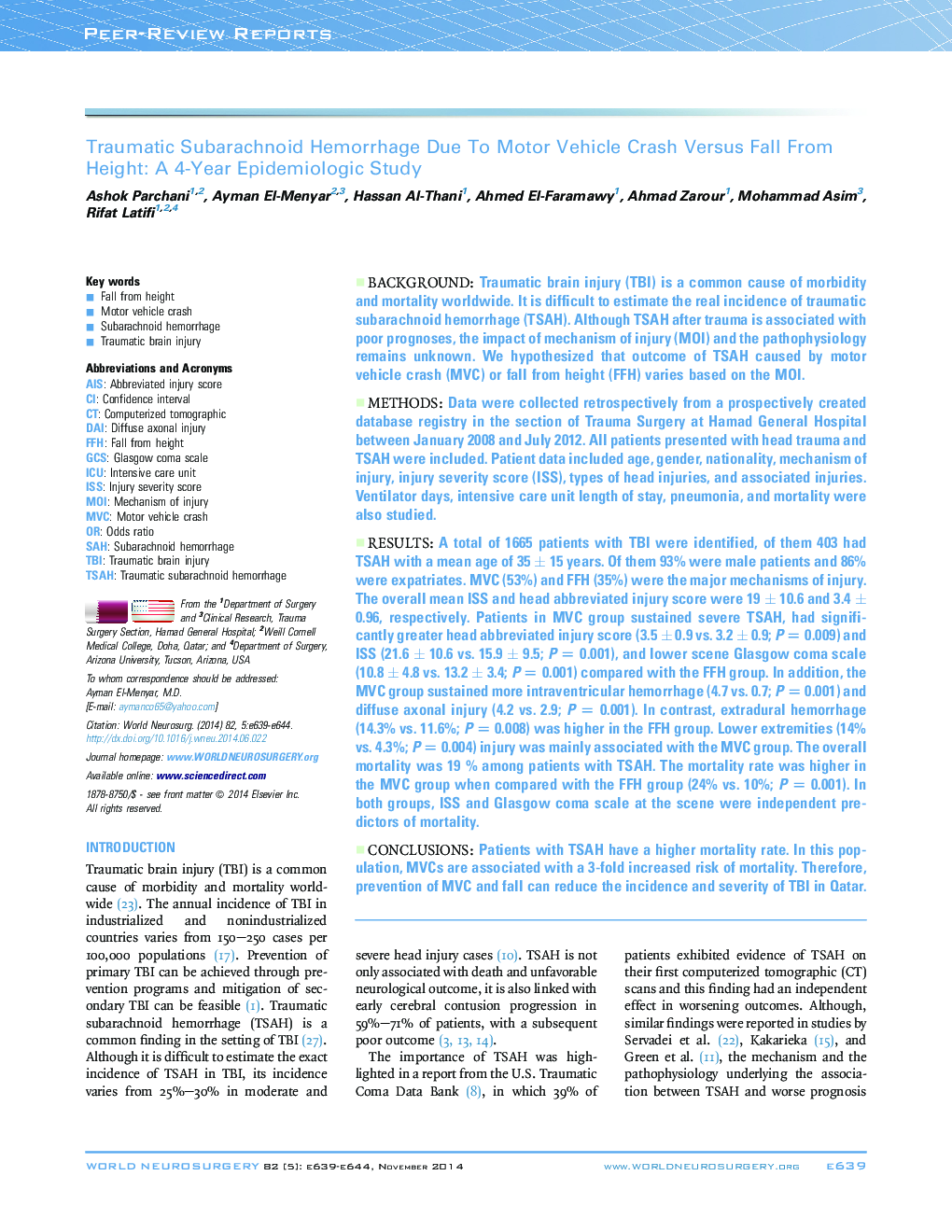| کد مقاله | کد نشریه | سال انتشار | مقاله انگلیسی | نسخه تمام متن |
|---|---|---|---|---|
| 3095361 | 1190909 | 2014 | 6 صفحه PDF | دانلود رایگان |
BackgroundTraumatic brain injury (TBI) is a common cause of morbidity and mortality worldwide. It is difficult to estimate the real incidence of traumatic subarachnoid hemorrhage (TSAH). Although TSAH after trauma is associated with poor prognoses, the impact of mechanism of injury (MOI) and the pathophysiology remains unknown. We hypothesized that outcome of TSAH caused by motor vehicle crash (MVC) or fall from height (FFH) varies based on the MOI.MethodsData were collected retrospectively from a prospectively created database registry in the section of Trauma Surgery at Hamad General Hospital between January 2008 and July 2012. All patients presented with head trauma and TSAH were included. Patient data included age, gender, nationality, mechanism of injury, injury severity score (ISS), types of head injuries, and associated injuries. Ventilator days, intensive care unit length of stay, pneumonia, and mortality were also studied.ResultsA total of 1665 patients with TBI were identified, of them 403 had TSAH with a mean age of 35 ± 15 years. Of them 93% were male patients and 86% were expatriates. MVC (53%) and FFH (35%) were the major mechanisms of injury. The overall mean ISS and head abbreviated injury score were 19 ± 10.6 and 3.4 ± 0.96, respectively. Patients in MVC group sustained severe TSAH, had significantly greater head abbreviated injury score (3.5 ± 0.9 vs. 3.2 ± 0.9; P = 0.009) and ISS (21.6 ± 10.6 vs. 15.9 ± 9.5; P = 0.001), and lower scene Glasgow coma scale (10.8 ± 4.8 vs. 13.2 ± 3.4; P = 0.001) compared with the FFH group. In addition, the MVC group sustained more intraventricular hemorrhage (4.7 vs. 0.7; P = 0.001) and diffuse axonal injury (4.2 vs. 2.9; P = 0.001). In contrast, extradural hemorrhage (14.3% vs. 11.6%; P = 0.008) was higher in the FFH group. Lower extremities (14% vs. 4.3%; P = 0.004) injury was mainly associated with the MVC group. The overall mortality was 19 % among patients with TSAH. The mortality rate was higher in the MVC group when compared with the FFH group (24% vs. 10%; P = 0.001). In both groups, ISS and Glasgow coma scale at the scene were independent predictors of mortality.ConclusionsPatients with TSAH have a higher mortality rate. In this population, MVCs are associated with a 3-fold increased risk of mortality. Therefore, prevention of MVC and fall can reduce the incidence and severity of TBI in Qatar.
Journal: World Neurosurgery - Volume 82, Issue 5, November 2014, Pages e639–e644
